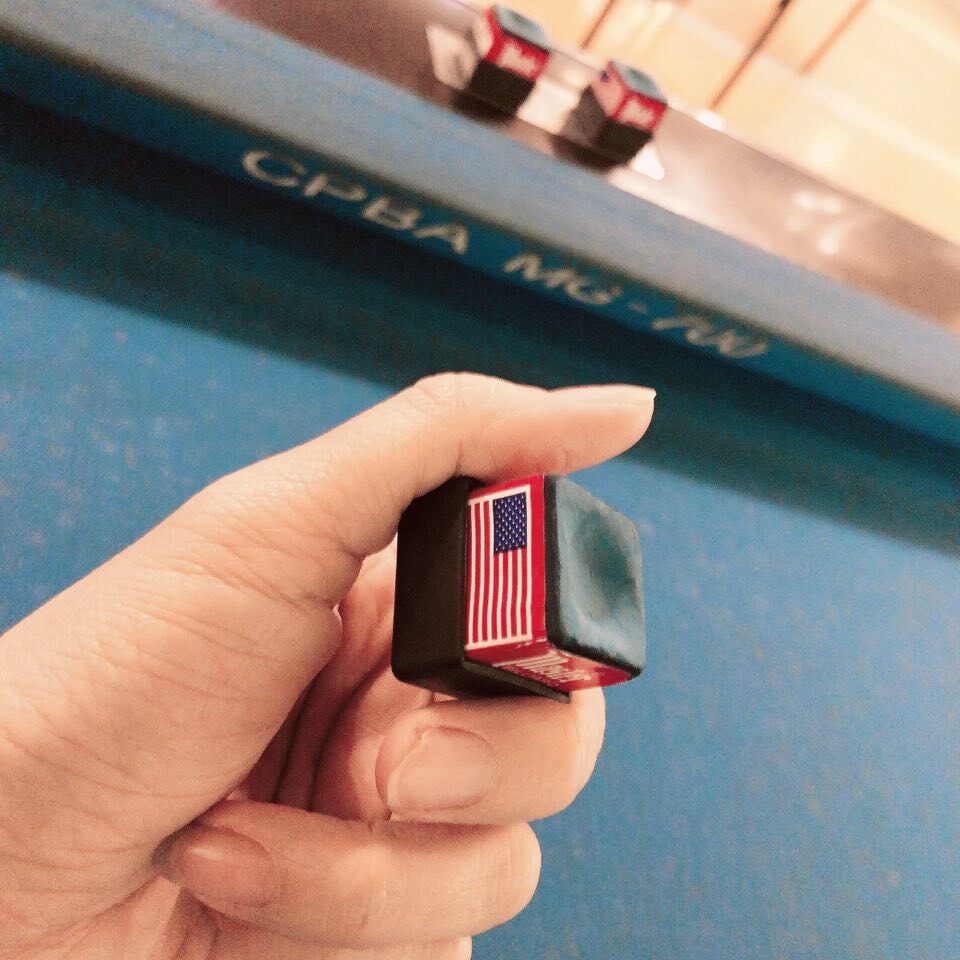On snowy roads, it’s better to wear snow shoes, leather shoes with spikes are less slippery.
In this article, we’ll talk about the chalk, which is an indispensable item when you hit the ball.
Before tips appeared, the cue was simply a wooden stick with a rounded tip.
But at the beginning of the 19th century, a pawnbroker in a port in England put white ink powder on the end of a cue, which he used to use to mark the destination of crates and other items.
Then, I was able to do a little hiccup.
Since then, the quality of play, etc., has improved dramatically, but the hinelli was born in England, and we now call the hinelli “English”.
In other words, the origin of chalk is white ink, which is formed by adding abrasives and pigments to a base material such as calcium carbonate to improve the consistency of the tip.
Incidentally, I’ve heard it said that “blue tips are blue because of the chalk component,” but that’s not true.
As I mentioned in the second part of this essay, blue leather is made by chrome tanning, which gives the leather a bluish-gray finish.
And by sprinkling pigment on it, the blue tips are blue in color.
So, why does applying chalk make it possible to hinge?
That’s because the abrasive has become a spike particle and is gripping the ball.
On snowy roads, spiked leather shoes are less slippery than regular leather shoes.
It’s the same thing.
That’s why the chalk creates spike marks on the surface of the ball every time you hit it.
The particles are so fine that the naked eye cannot see the scratches, but it can be said that it is the chalk that determines the life of the ball.
Of course, as far as the tips are concerned, they’re being scraped off each time the chalk is applied.
To find out “how much of a chalk difference the same tip makes.
I did a test with the same settings and the same cries for the same points.
It is the fineness of the spike particles that determines the performance of the chalk.
Each company is slightly different in the fineness of the count of the file, whether it is smooth or slippery when it is applied.
The old “National Tournament Chalk” was manufactured in Chicago and was commonly referred to as “National Chicago”, but it was said to be a “phantom masterpiece” and many people were willing to pay thousands of yen to have it.
At Pocket Billiards, many people say the best chalk is the old “Brunswick” chalk, including the popular “brown bra” which has a brown package.
There were various other chokes, and I think there are still more than 100 stocks.
Incidentally, while “master” chalk, which is commonly used today, tends to be a bit flaky, old chalk tends to be moist and has fine particles.
When we were developing the tip, we wanted to see how much of a difference the same tip would make to the chalk, so we tested four of the most popular brands – National Tournament Chalk, Brunswick, Master and Triangle – with the same settings and the same cue.
I have used dozens of other types of chalk, but based on my experience, I don’t think there is much difference between these four brands in terms of total balance: “not too much damage to the ball”, “not too dirty”, and “good bite”, and I think using any one of them is sufficient.
Of course, when it comes to how well it bites the ball, I think the “masterpiece” is better than the four brands.
However, on the other hand, there are some disadvantages such as “the ball gets dirty easily” and “it’s a little too sticky”, and even if it’s a masterpiece, we haven’t seen anything that can be called “perfect”.
If that’s the case, I think it’s enough to use any of the four stocks without daring to choose the ones that are hard to get or expensive.
When you hit it, the fibers of the tip are cut with a thud.
The surface would be uprooted.
Most billiard fields have chalk available.
I think a lot of people have used it and have been able to play without any problems, but I still think it’s better to have a michoke.
There is a difference in the way people apply chalk.
The shape of the chalk surface also gives it a personality, such as a bowl shape or a “+” pattern, but if the chalk is made in a different way from your own, it is surprisingly difficult to paint beautifully.
Also, let’s say you have someone who has been using a master for years, for example.
The master is probably the most popular chalk, but that said, it’s not always in every shop.
Therefore, if you don’t have my chalk, you may be forced to use a different brand of chalk than the master.
The ratio of ingredients in chalk varies slightly from manufacturer to manufacturer.
In other words, if you use different chalk than usual, you are mixing different particles together on the surface of the tip, which takes away the character of the chalk and is not good for the tip.
The point is, “Don’t mix the chalk”.
I think it’s better to have my chalk in that regard as well, and if you want to use a different chalk, I think it’s better to wipe off the chalk on the tip before using it.
Also, there are some things to be aware of when using chalk.
The surface of the ball is coated with wax, and when you hit the ball, it sticks to the tip.
When the chalk is applied in that condition, the wax on the tip will move to the chalk as well, resulting in wax on both the tip and the chalk.
In this condition, no matter how much chalk you apply, you will only be catching the wax between the chalk and the tip, so the tip will be slippery when you hit it, and there is a high probability that you will miss.
If the chalk is waxed, the surface of the chalk will look oily.
When this happens, wipe it off with a tissue and reset it.
One more thing.
It’s also not a good idea to file the tip to make the surface fuzzy just because the chalk is not very smooth.
On a micro level, if there are chalk spike particles between the filed bristles, the tip fibers will be cut off and the surface will be uprooted when you hit the ball, causing a mistake.
This is a particularly common mistake when using the crescendo at the end of the ring.
Think of the people you play with and the stores you shop with.
Choose your chalk and use it with good manners
Chalk is a must-have in the game of billiards, but it also makes a mess of the ball and the table.
So, in terms of the quality of the glue, some of the chokes are better than the four typical chokes mentioned above, but you have to be careful when using such chokes.
If the spike particles are too sharp, they may not be able to be wiped off if the chalk powder is scattered on the rasha, and especially in pocket billiards, where the players take turns hitting the same ball, you don’t want your opponent to use too much chalk to stain the ball.
If the chalk is all over the place where you want to hit it, you can’t hit it there anymore.
In the future, an alternative to chalk may be invented.
It’s a sticky spray that dries quickly when sprayed on.
But I think that the chalking gesture is so well established in the culture that even people who don’t know billiards well can understand it as an “image of billiards”.
So, it’s probably a long way off before we have a replacement for chalk.
As long as you continue to use chalk, it is important that you choose chalk with consideration for the people you are playing with and the shops, and that you use it with good manners.
The tables and other utensils are shared by everyone, and billiards has always been a noble game, far from being the word “hustler”.




